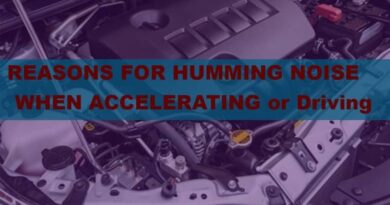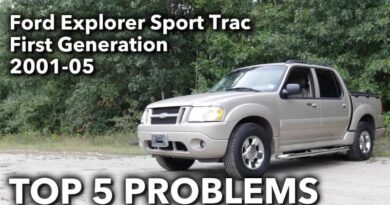
A high-pitched screeching noise when driving indicates that one or more automotive parts are damaged. When driving slowly or quickly, strange noises from your car can be humiliating and cause you to get concerned.
These noises are beneficial because they serve as warning indications that anything is wrong.
This video will provide you with a potential cause and solution for the issue. It’s possible that the noise didn’t start the day your car acquired the problem. It can be the result of a defective component that will shortly fail.
The fact that the issue is frequently obscured by background noise doesn’t give us an excuse to disregard it; whether it’s as quiet as chirps and squeaks or as loud as shrieks and screams, every sound has an origin that can be traced.
The Top reasons for the Eruption of the High-Pitched Squeal
Broken Brake Pads
Brake pads worn out are one of the most typical reasons for a high-pitched screech when moving. The high-pitched noise is brought on by a metal indicator contacting the rotor as the pads deteriorate. This implies that you should replace your brake pads right now.
Unbalanced Belts
When the engine operates, belts out of alignment in your car’s system may screech loudly. This may happen due to accessory belt wear, inappropriate tension, or other factors.
Loose or Damaged Pulleys
Pulleys are essential components in various systems of your car. When these pulleys become loose or damaged, they can create a high-pitched squeal while the vehicle is in motion.
Problematic Wheel Bearings
Bad wheel bearings might also cause high-pitched squeals. Wheel bearings are most likely to blame if you discover that the noise gets louder when you make turns.
Serpentine Belt Problem
The alternator and air conditioning compressors are just a few parts of your car’s engine driven by the serpentine belt. This belt may emit a high-pitched squeal if worn out or broken.
Worn-out Suspension Components
Your car’s suspension system has various components that can wear out over time. When these components become worn, they can produce a high-pitched squeal while driving.
Diagnosing the Problem
Searching Squealing Noise When Driving
Paying closely to the sound and attempting to identify its source is the first step in identifying the problem. Is the noise under the hood louder than it is near the wheels? This first observation can offer important insights.
Checking the Brake Rotors and Pads
It’s critical to check the quality of the brake pads and rotors if the noise appears to be coming from the wheels. Look for thinning, wear, and any apparent damage. If the rotors or pads are severely damaged, they can require quick replacement or repair.
Inspecting the State of the Pulleys and Belts
Check the state of the pulleys and belts if noises are coming from the engine area. Check for indications of wear, damage, or misalignment.
Belt adjustment or replacement may be required if any problems are discovered. Pulleys that have been damaged should also be fixed or replaced.
Inspecting the Wheel Bearings
Visually inspect the wheels to see if the noise is coming from the bearings. Check the bearings for symptoms of deterioration or wear. Additionally, inspect the wheel for any looseness or play when the wheel is jacked up. It is preferable to address issues as soon as they become apparent.
Realignment of Belts
In the case of misaligned belts, proper realignment is necessary. This can be done by adjusting the tension or seeking assistance from a mechanic.
Repairing or Replacing Damaged Pulleys
Damaged pulleys should be repaired or replaced to eliminate the high-pitched noise. It’s advisable to consult a professional to ensure proper installation.
Replacing the Serpentine Belt
If the serpentine belt is worn or damaged, it’s essential to replace it. This can restore the proper functioning of the engine components driven by the belt.
Preventive Maintenance
Regular preventive maintenance is crucial to avoid future occurrences of a high-pitched squeal. Let’s explore some maintenance tips for the components we discussed.
Regular Brake Inspections and Maintenance
Schedule regular brake inspections to check the condition of the pads and rotors. Performing brake maintenance, such as cleaning and lubrication, can also prolong the lifespan of these components.
Belt and Pulley Checks
Inspect the belts and pulleys periodically for wear, misalignment, or damage. Adjust belt tension if needed and replace worn-out belts promptly.
Wheel Bearing Maintenance
Include wheel bearing inspection in your routine vehicle maintenance. Greasing or replacing worn-out wheel bearings can help prevent the high-pitched squeal.
Brake Rotor Care
Keep brake rotors clean and free from debris. Avoid excessive braking and harsh driving habits that can accelerate rotor wear.
Suspension Component Maintenance
Regularly inspect suspension components for signs of wear or damage. Replace worn-out components and ensure proper lubrication of moving parts.
The Bottom Line
When your car is moving, a high-pitched screech from it can be a worrying problem. You can assure the efficiency and security of your vehicle by comprehending the typical causes and adhering to the measures to identify and fix the issue. Remember to take prompt action and, if needed, seek professional assistance.
Frequently Asked Questions
FAQ 1: Can a loose belt cause other issues in the car?
Yes, a loose belt can cause other issues in your car. It can affect the performance of belt-driven components, such as the alternator, power steering pump, and air conditioning compressor. It’s important to address a loose belt to prevent further damage.
FAQ 2: What are the signs of a failing wheel bearing?
Signs of a failing wheel bearing include a high-pitched squeal or grinding noise, vibration or shaking while driving, uneven tyre wear, and excessive play or looseness in the wheel.
FAQ 3: How frequently should I check the suspension parts?
Regular inspections of suspension components are recommended every 12,000 to 15,000 miles or per your vehicle manufacturer’s guidelines.
It’s essential to check for signs of wear or damage and address any issues promptly to maintain a smooth and comfortable ride.


